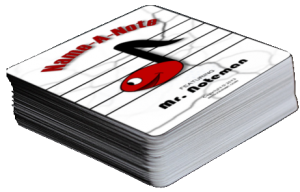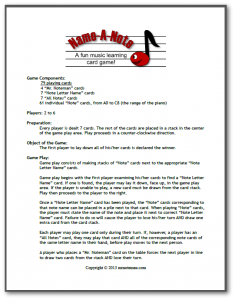For my music classroom this year, I made a set of 3 posters.
I had them printed at the local Walmart photo department as 8″X20″ posters. They look great!

For my music classroom this year, I made a set of 3 posters.
My latest project, music note playing cards, is now available. I call it the Name-A-Note game.

The Name-A-Note card game, featuring Mr. Noteman the music note puppet, is a fun educational game for learning the names of music notes on the music staff. This set of cards contains all 52 notes encompassing the range of a standard piano, also including some overlapping notes on ledger lines between the treble and bass clef staff lines. There are a total of 79 cards.
Click on the picture below to read the rules of the game. A listing of all the note cards is also included.
 Name-A-Note Game Documentation
Name-A-Note Game Documentation
Every year I make an academic calendar for myself to use in personal planning. If you would find it useful, feel free to download and print a copy for yourself.
Free academic calendar! Download and print now!
Instructions:
Here’s an interesting way of presenting the effect that music has on people.
At our house, we are starting instrument lessons. Here is our new Mr. Noteman music practice report chart.
I introduced the whole family of Noteman Babies to my music students this week. Within about 10 minutes, the children could identify them by name and sing their note.
The red one is Baby Do, orange is Baby Re, yellow is Baby Mi, green is Baby Fa, blue is Baby So, purple is Baby La, and pink is Baby Ti.
We played several fun games with the Noteman Babies and had a grand time. The children all did an excellent job of identifying them and singing on pitch.
Here are some colored solfege cards I made to help teach the colors to the children.
Take a group of kindergartners to a piano and ask one of them to make angry sounds on the piano. You will immediately get loud, low, deliberate banging sounds. Ask another one to play happy sounds. The child will instinctively play light, high-pitched, fast notes. Ask yet another child to make sad sounds and you will hear slow, mid-range to low, soft notes. These sounds will be created by children who know nothing of piano playing, much less traditional music theory.
What is their secret? How do they know what the music is saying?
Children innately understand that they can make sounds which mimic a person’s physical and emotional reactions. A person who is angry, for example, will make big motions, will talk in low, harsh, loud tones, and move about in a very deliberate manner. Recreating the emotion of anger on a piano then becomes simply a matter of doing the same things.
Take this exercise a step further, and you might be shocked at how proficient these small musicians are at using music to communicate. Ask a small child to think of an animal and portray that animal on the piano. See how quickly the other children can guess what the first child is thinking. In my experience, usually within 1 or 2 tries, the other kids know what animal was being “played” on the piano.
Music has the capability to communicate on so many different levels. It can communicate the emotions of anger, happiness, sadness, loneliness, joy, satisfaction, discontentment, and any other feeling you might experience. Music communicates physically, mentally and spiritually. And children are very much aware of this.
Years ago, when my children were very small, probably 2-4 years old, I played a CD for them of John Phillips Sousa marches, played by a marching band. Their response was obvious and immediate. They merrily started marching around the house in a perfect parade line, waving flags and stepping in time to the music. This was not something I taught them.
Children innately understand how music communicates.
Now, here’s a lady who knows how to teach music to small children! You’ve got to watch this video. Notice her use of rhythm manipulatives as well.
Candida Tobin introduces harmony
Here’s the story about how I happened to discover this video. In my last couple of posts, I introduced the Noteman Babies. My plan is to make them in 7 different colors and correlate them to the 7 pitches in the musical scale. Boomwhackers use this method, for example. I can think of tons of music learning games that could make use of these cool music education toys. (By the way, I introduced the Noteman Babies to my elementary music classes this week, and the kids really loved them!) I discovered that my music notation software, MuseScore, has the ability to print colored note heads, corresponding to the Boomwhacker colors. During the process of learning about all of this, I found a reference to a guitar teacher who used the Candida Tobin method, so I had to find out more.
I love her approach, but would probably go with the closer-to-a-standard colors of the Boomwhackers.
If you like this, you’ve got to go here to download another video about her system: http://tobinmusic.co.uk/content/video/requestVideo.htm
Highly recommended!
I’m calling it “The Singer’s Song.” Part one teaches good singing technique. Part two covers the main elements of music: melody, harmony, rhythm, and expressive elements. Part three teaches the concept of high and low notes. Put them all together for a wonderfully harmonious and fun canon.
Let me know what you think!
Free music download here:
>>>>The Singer’s Song<<<<
My wife and I dropped by the fabric store this evening and I was able to pick up some red and black craft foam, as well as some sticky-back eyes. A few snips after arriving back home, the new Mr. Noteman Finger Puppet was born. Don’t you wish you had one?
Make your own with this incredible, handy dandy pattern with directions!